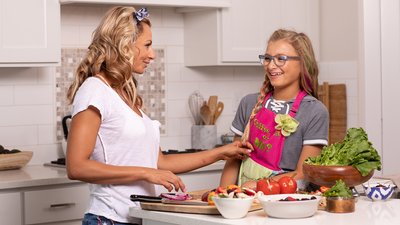We all know how important good nutrition habits are when it comes to our family's health. Most parents make a conscious effort to put healthy meals and snacks in front of their kids, and try to instill in them an appreciation for quality food. Despite all those best efforts, though, it's not uncommon to hear, "No, thanks, Mom and Dad, I'll just have some butter on those plain noodles and skip the broccoli."
For many parents, the struggle to get their kids to eat healthy foods can seem like another full-time job. Rather than battle with your kids about following hard-to-enforce food rules ("No dessert ever until you eat your veggies"), why not involve your kids in the actual process of choosing and preparing healthy meals and snacks?
That's how Bodybuilding.com-sponsored athlete Nikki Walter is raising her 12-year-old daughter, Addie, and what she's learned can help you raise your kids, too.
Why is it so important to teach your daughter how to eat well?
Even though it usually feels like the opposite, kids hear and see everything the adults in their lives do. If you want your kids to live long, healthy lives, you have to make sure that what you expose them to supports that goal.
Health, wellness, and exercise have always been a part of my life. Life is change, and as it changes, I've learned to keep an open mind and adapt as needed. The biggest change in my life was when I became a 32-year-old widow with a 5-year-old daughter. Even with that tectonic shift in my life, I was still determined to show my daughter that, no matter the circumstances, you can still make good choices.

As the two of us learned a new way of living without a father and husband, I realized that whenever I was dieting for a competition, my daughter and I were eating completely different meals. That was not how I wanted to raise her, so I slowly began introducing her to my diet. I quickly discovered that, like any other normal child, she was not crazy about a steady diet of fish and broccoli. Rather than give up on the idea of exposing her to healthier options, I started experimenting with different ways to prepare the foods I was eating.
I started by seasoning the fish differently, asking her how she liked it, then working with her to come up with our next fish recipe. I found that by using her ideas, and then encouraging her to help me prepare it, she was much more apt to eat what was on her plate. We made a game of it, and, in the process, found lots of new ways to cook our main course. Then, it was on to the side dish.
One night, as we were preparing dinner, my daughter told me that she liked broccoli, she just didn't like it grilled or raw the way I liked it. If we steamed the broccoli, she said, she'd eat it! This was a small moment but an important one, because I understood that even the most basic ways I prepared things might not suit her. Now, the more quality time we spend together in the kitchen, the more I learn about her food preferences.
These and other experiences with my daughter have taught me that the more we create an environment of exploration, honesty, and fun, the more receptive our kids will be to the new habits we're trying to instill in them.
How do you encourage your daughter to make healthy eating part of her daily life?
We start by shopping together. Then, we discuss our meals, and we bring her nanny up to speed on what meals and snacks we're planning. For us, taking some responsibility for food prep is key. If my daughter chooses to have fruit for snacks, it's her job to wash, cut, and bag them while I prep other parts of the meals for the week. Grapes that sit on the vine in our house go to waste, so she's gotten in the habit of taking them off the vine, washing them, and putting them in a small bag in the fridge. When she needs a snack, the little bags of fruit and vegetables she's chosen are washed, packed, and ready for her to grab and go.

As my daughter gets older, I've also begun to monitor her sugar intake more closely. She loves to bake now, but she knows she has to choose the right combination of baked goods and other foods to keep her overall sugar consumption under control.
The most important thing is to make the preparation of good foods fun for her. She loves to make videos for her Instagram page, "Kids Kitchen with Addie," and when we're preparing a cooking party, we always plan a little gift bag and note for the kids from "lilmiss," my daughter's nickname.
What are some of the best ways parents and other caregivers can make healthy eating fun and interactive?
Addie and I strive to help parents and children understand how they can make changes to live as healthily as possible. Here are some of our most popular tips for creating new habits:
Measure, but make it fun. Eating a healthy diet often includes measuring, which can seem like a real chore for some kids. Give your children a drawer filled with their own measuring cups and spoons and kitchen utensils. Show them how to read labels and measure a serving. Then, teach them how the size of a serving relates to the amount of nutrients their bodies need.
Help them visualize their daily sugar and salt consumption. For each meal of the day, measure the serving of sugars and sodium found in those foods and pour that amount of sugar or salt into a glass. Then, hand your child a spoon and ask if they want to eat all the salt and sugar that's in there. That's all it takes for most kids to become much more conscious of their food choices.
Give them a logbook to track their eating habits. Encourage children to track their activities and food by making it fun. Buy a logbook off the shelf, or create a weekly punch card that keeps track of the treats, veggies, and proteins your kids consume every day. Reward your kids as you see fit for choosing healthy foods.
Explain to your kids why healthy choices are so important. When Addie was still quite small, I started talking to her—at her level—about disease, obesity, and genetics. You have to talk about these things in a way that doesn't scare them, but you might be surprised by how interested they can be in knowing the facts. I make a habit of regularly showing my daughter documentary films and articles on a variety of health-related topics.
Allow occasional treats, but make it a learning opportunity. I don't believe in deprivation, so I allow Addie to pick a "choice" (not "cheat") meal every now and then. I would much rather communicate openly with my child and empower her to make healthy food decisions, and then give her the freedom to eat unhealthy food every now and then. Otherwise, you run the risk of forcing them to sneak in those foods when you're not looking. Our kids need to trust us, and in return, we need to trust them to make their own decisions—good and bad—and understand the consequences.
Keep it simple. My favorite recommendation is to teach kids to ask these three basic questions: May I have a snack? What snack can I have? How much of it can I have? Instilling this habit in kids takes time, but it's important for them to understand that if they want a snack, they have to ask. When I started this with Addie, she was 7 years old. She's 12 now, and still asks me these three simple questions.

How do you handle portion sizes?
One question I hear from parents all the time has to do with the portion sizes they should give their kids. I always remind them to keep tabs on their children's activity levels so they can match the amount of calories their kids consume to their age and the amount of exercise they get. Try not to have conversations with your kids that connect portion size to body size, which can lead to kids worrying about their weight. Instead, focus on the idea that good food choices encourage their bodies to grow strong and healthy.
The bottom line is that the only way our children will know how to make healthy choices is if we teach them. Many parents don't believe they have the knowledge or the skills to help their children make good choices. The energy we invest in acquiring these skills and knowledge for ourselves will benefit our kids—and help us live healthier lives, too!



